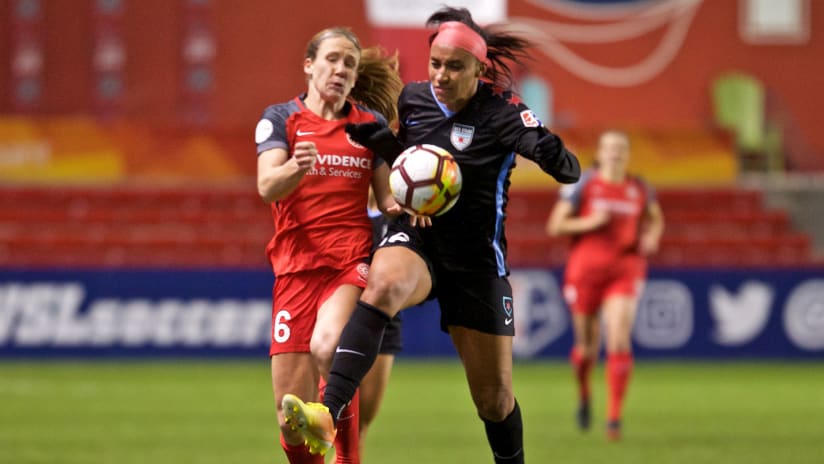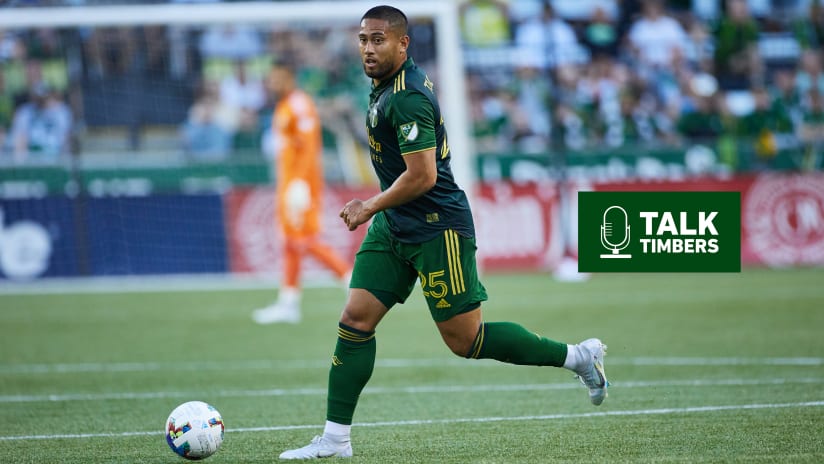To the extent answers in NWSL mixed zones qualify as letting cats out of bags, Thorns FC head coach Mark Parsons did as much after his team’s opening-weekend game against in North Carolina.
“It’s funny, we’re going on 13, 14 games, nobody is realizing, we press everything,” he said, after his team’s 1-0 loss to the Courage. “We get pressure on the ball, in every area.
“It’s interesting, because tacticians around the league haven’t noticed it, and while they haven’t noticed it, we’ll keep going.”
Surely, after Saturday’s victory in Chicago, those tacticians will start to take notice. Playing the same way they have since the middle of last season, the Thorns used high, constant pressure from their two forwards to dictate the game’s tempo. The approach helped produce the corner kick that led to the game’s opening, ninth-minute score as well as the turnover which restored Portland’s lead just before halftime. Although players like Mallory Weber, Tyler Lussi, Ifeoma Onumonu and Midge Purce didn’t get on the scoresheet, their effort up top enabled the Thorns to leave Chicago with a 3-2 win.
Over the last week, we’ve spent a lot of time talking about that press, mentioning it both after the signing of Ana Crnogorčević and in the wake of Saturday’s game. To really see the difference in approach, though, it’s best to make a direct comparison - to look at how the team set up last year and compare it to what we’re seeing now.
Here is a clip from the first game of last season, with the Thorns at home against the Orlando Pride. You can see the longer version here (full games are available on the NWSL website), but this GIF should give you an idea.
The first things to note here are the shape and movement. One year ago, Christine Sinclair was alone atop a single-forward shape, with Lindsey Horan behind in essentially a 4-2-3-1 formation. As Orlando moves the ball, Sinclair and Co. are patient, waiting for the Pride’s movement to trigger a response.
Often, you’ll hear coaches talk about this in terms of their press. It comes down to triggers and traps. When a team’s build up does a certain thing you’ve planned for, it triggers a response. That response, or the play itself, will funnel the ball into a trap, from which you try to win the ball or force a turnover.
Above, Sinclair’s waiting for Orlando’s play (the trigger) to allow her to cut off the field. Her response, as well as her teammates’, funnels the ball to a certain spot, where Horan has a chance to turn Orlando over.
Compare the intensity of that sequence to this one, from Saturday in Chicago. Below, the Thorns have just hit a long ball out of their own half, to the feet of Chicago’s goalkeeper, Alyssa Naeher, giving them a chance to set up their press. Instead of having one forward patiently steering play, one of the Thorns’ two forwards, Weber, is moving the moment Naeher plays the ball to Samantha Johnson.
This sequence went on for two or three more passes, with the Thorns eventually winning the ball in the center circle. As you can see, though, no ball is left uncontested. In Parsons' words, the Thorns “get pressure on the ball, in every area.” And as that pressure becomes greater and greater, the Red Stars eventually give up the ball.
Admittedly, when I first truly started watching soccer -- I mean really watching soccer -- a decade-or-so ago, I probably wouldn’t have noticed the difference; or, if I noticed, I probably wouldn’t have cared. No team I’d ever played on taught soccer in this way, and to the extent I learned that before I got into this profession, my eye wasn’t trained enough to see it. If those GIFs just look like a bunch of people running after a ball, don’t worry. You’re not alone.
But there are major, fundamental differences between the two approaches. One year ago, the Thorns might have been trying to win the ball high, but to the extent they were pressing, they were doing so as many other teams do, in response to specific triggers. Now, the Thorns are just going. Their defense is dictating play instead of waiting to be dictated to.
This is a very demanding way to play, and in continuously pushing up against each opponent, it can prove risky, too. It leaves space behind, making it all the more important that, behind your press, you have fast, intelligent players capable of dealing with any mistakes made higher up the field.
But the approach can also have a psychological effect on your opponents, a type of mental wear-and-tear that can accumulate as matches wear on. Players constantly pressured to make the right decisions, with little time to do so, are more likely to crack and make a mistake. If you’re pressing high up the field, those mistakes come closer to goal.
As the Thorns approached halftime on Saturday, that crack finally came. Chicago had been under pressure most of the first half when Naeher’s errant, 38th minute pass gifted Weber a shot at an empty goal. Although her shot flew high, Chicago cracked again two minutes later, giving the Thorns their second goal:
Think about this in terms of triggers and traps – the coaching jargon we mentioned, above. In both cases, this year’s and last’s, the Thorns are setting up play so that their midfielders can challenge the ball, but the triggers are entirely different. A year ago, it was Orlando’s play that triggered Portland’s trap. This season, actively pressing with two forwards, the Thorns are, for the most part, supplying their own triggers.
This becomes important in understanding why the Thorns have targeted specific types of forwards such as Crnogorčević and Caitlin Foord. It’s vital to understanding why Weber, Lussi, Onumonu and Purce’s contributions were so valuable, and it’s key to knowing why the Courage, pressing in somewhat similar ways, has been so successful over the last three seasons. It’s also important in seeing why, when opposing teams seem to make simple mistakes, they’re actually the product of a lot of Thorns work.
When the Thorns press executes like it did on Saturday, you’re going to see easy goals. That’s the point. And those teams that can avoid conceding easy goals? They’ll likely come in two forms: Ones that are kicking the ball away and allowing the Horans, Sinclairs and Tobin Heaths more time on the ball, and ones that might actually force Parsons to alter this approach.














